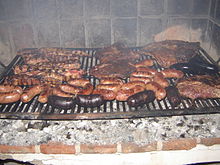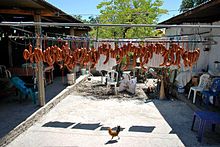Chorizo
 Curing chorizos | |
| Course | Side dish |
|---|---|
| Place of origin | Spain[1] and Portugal |
| Region or state | Iberian Peninsula, Latin America, East Timor, Philippines, Goa (India) |
| Serving temperature | Hot or room temperature |
| Main ingredients | Pork, paprika |
Chorizo (/tʃəˈriːzoʊ, -soʊ/,[2][3] from Spanish [tʃoˈɾiθo]; Portuguese chouriço [ʃo(w)ˈɾisu]) is a type of pork sausage originating from the Iberian Peninsula. It is made in many national and regional varieties in several countries on different continents. Some of these varieties are quite different from each other, occasionally leading to confusion or disagreements over the names and identities of the products in question.
In
Iberian chorizo is eaten sliced in a sandwich, grilled, fried, or simmered in liquid, including apple cider or strong alcoholic beverages such as aguardiente. It is also used as a partial replacement for ground (minced) beef or pork.[4]
Names
This section needs additional citations for verification. (August 2021) |
The word chorizo probably comes from the
In English, chorizo is usually pronounced
Pronunciation and spelling vary slightly among the
- Asturleonese: chorizu [tʃoˈɾiθu]
- Basque: txorizo [tʃoˈɾis̻o]
- Catalan: xoriço [ʃuˈɾisu]
- Galician: chourizo [tʃowˈɾiθʊ]
- Portuguese: chouriço [ʃo(w)ˈɾisu]
- Spanish: chorizo [tʃoˈɾiθo], [tʃoˈɾiso]
Varieties by region
This section needs additional citations for verification. (August 2021) |
Europe
According to the EU geographical indications register,[8] in 2023, there were 8 recognized varieties in Portugal: Chouriço de Ossos de Vinhais, Azedo de Vinhais, Mouro de Portalegre, Abóbora de Barroso-Montalegre, Portalegre, Carne de Estremoz, Estremoz e Borba, and do Baixo Alentejo. In Spain there are two varieties recognized: Chorizo Riojano, and Chorizo de Cantimpalos.
Spain

Generally, Spanish chorizo is made from coarsely chopped pork and pork fat, seasoned with garlic, pimentón – a smoked
Chorizo is made in short or long and hard or soft varieties; leaner varieties are suited to being eaten at room temperature as an appetizer or tapas, whereas the fattier versions are generally used for cooking.[10] A rule of thumb is that long, thin chorizos are sweet, and short chorizos are spicy, although this is not always the case.[11]
Spain produces many other pork specialties as well, such as
Depending on the variety, chorizo can be eaten sliced without further cooking, for example in a sandwich, or can be grilled, fried, or baked alongside other foodstuffs, and is an ingredient in several dishes where it accompanies beans, such as
Versions of these dishes con todos los sacramentos (with all the trimmings, literally "
Portugal

Portuguese chouriço or chouriça, the latter usually denoting a larger or thicker version, is distinct from Spanish chorizo. The base ingredients are pork, fat, paprika, garlic, and salt. Wine and hot peppers are also common in some regions. It is then stuffed into natural casings from pig or lamb and slowly dried over smoke.[14] The many different varieties differ in color, shape, spices and taste. White pepper, piri-piri, cumin and cinnamon are used in some varieties. Many dishes of Portuguese and Brazilian cuisine make use of chouriço, including cozido à portuguesa and feijoada.[15][16]

A popular way to prepare chouriço is slicing it part-way through and cooking it over an alcohol flame at the table (sometimes called chouriço à bombeiro,[17] but more commonly just chouriço assado) in purpose-made glazed earthenware dishes with a lattice top.
In
In the heavily Portuguese counties in the US states of
In Portugal, chouriço can be made with blood, similar to
Americas
Mexico
Based on the uncooked Spanish chorizo fresco (fresh chorizo), the Mexican versions of chorizo are made not only from fatty pork, but also
This is the main type of chorizo known in Mexico and other parts of the Americas, including most of the United States, but is not frequently found in Europe.

The area around
In Mexico, restaurants and food stands make tacos,
Central America and the Caribbean

In Puerto Rico, Panama, and the Dominican Republic, chorizo and longaniza are considered two different types of meat. Puerto Rican chorizo is a smoked, well-seasoned sausage nearly identical to the smoked versions in Spain. Puerto Rican and Dominican longanizas have a very different taste and appearance. The seasoned meat is stuffed into a pork casing and is formed very long by hand. It is then hung to air-dry. Longaniza can then be fried in oil or cooked with rice or beans. It is eaten with many different dishes.
Salvadorean chorizo is short, fresh (not dried) and tied in twins.
United States
In contrast to Spanish chorizo, in the United States the term generally refers to a sausage that is never dried, has a fattier filling, and is very spicy. It is most popular in areas with large Cuban, Dominican, or Puerto Rican populations or near the Mexican border, especially in the Southwest near
In Louisiana, Creole and
South America

In
In Argentina,[28] Uruguay, Bolivia, Peru, Colombia and Venezuela, chorizo is the name for any coarse meat sausage. Spanish-style chorizo is also available, and is distinguished by the name chorizo español ('Spanish chorizo'). Argentine chorizos are normally made of pork, and are not spicy hot. Some Argentine chorizos include other types of meat, typically beef. In Argentina, Bolivia, Paraguay, Uruguay, Chile, and Peru, fresh chorizo, cooked and served in a bread roll, is called a choripán. In Colombia, chorizo is usually accompanied by arepa.
In Brazil, chouriço is the word used for what in the rest of Latin America is morcilla; meat sausages similar to the chorizos of other Latin American countries are called linguiça. Many varieties of Portuguese-style chouriço and linguiça are used in many different types of dishes, such as feijoada.
In
South and Southeast Asia
East Timor

Chouriço is made in East Timor. It was introduced by the Portuguese, with their colonization of East Timor.
Goa
In Goa, India, which was ruled by the Portuguese for 450 years and has a large percentage of Goan Catholics, chouriço is made from pork that is marinated in a mixture of vinegar, red chilies, and spices such as garlic, ginger, cumin, turmeric, cloves, pepper, and cinnamon, and stuffed into casings.[29] They can be raw (wet), smoked or cured through salting and air-drying. These are enjoyed either with the local Goan Portuguese-style crusty bread, or pearl onions, or both. The sausages are also used, cut into chunks, as the meat ingredient in rice pilaf.
Three kinds of chouriço are found in Goa: dry, wet, and skin. Dry chouriço is aged in the sun for long periods (three months or more). Wet chouriço has been aged for about a month or less. Skin chouriço, also aged, is rare and difficult to find. It consists primarily of minced pork skin along with some of its subcutaneous fat. All three chouriços are made in variations such as hot, medium, and mild. Other variations exist, depending on the size of the links, which range from 1 to 6 inches (2.5–15 cm). Typically, the wet varieties tend to be longer than the dry ones.
Goan chouriço should be distinguished from "Goan frankfurters", which look similar to equivalents in the United States, but have a predominantly peppercorn flavor.
Philippines
Longaniza (
See also
References
- PMID 22055940.
- ^ "Definition of CHORIZO". Merriam-Webster.
- ^ "CHORIZO | meaning in the Cambridge English Dictionary". dictionary.cambridge.org.
- ISBN 978-0-8117-1693-2.
- ^ "Etimología de Chorizo", deChile.net s.v.
- ^ Oxford English Dictionary, 1st edition, 1910, s.v. 'sausage'
- ^ "Chorizo | Definition of Chorizo by Merriam-Webster". Merriam-Webster. Retrieved 18 November 2016.
- ^ "eAmbrosia". ec.europa.eu.
- ^ "Chorizos a la sidra - Spanish traditional recipe". Lobby Market. 7 February 2023.
- ISBN 978-0841672277.
- ISBN 0681304006.
- ^ "Sweet & Smokey". Archived from the original on 12 May 2015. Retrieved 6 August 2015.
- ^ Kroeger, Tim (6 June 2020). "Easy Chorizo al Vino Tinto (Chorizo in Red Wine) Recipe". Retrieved 5 June 2021.
- ^ Santos, Nina (23 July 2017). "A Guide to Portugal's Different Sausages". Culture Trip.
- ISBN 9789814435628.
- ^ Esposito, Shaylyn. "How to Make Feijoada, Brazil's National Dish, Including a Recipe From Emeril Lagasse". Smithsonian Magazine.
- ^ "Chouriço à Bombeiro (Flame Grilled Chouriço)". Easyportugueserecipes.com. 11 August 2015. Retrieved 11 October 2016.
- ^ Abundant Portuguese Residents Elude The South African Census, The New York Times, 29 May 1981
- ^ "Lusito Land Festival announces mouth-wateringly blissful menus". iloveza.com.
- ISBN 9781442227316– via Google Books.
- ^ "Traditional Cape Cod Linguisa Stuffed Quahogs". Cape Cod LIFE. 20 June 2017.
- ^ "Sausages & Salamis". clovegarden.com.
- ^ "Chorizo Recipes for the Spice Lover in All of Us". Lets-make-sausage.com. Retrieved 11 October 2016.
- ^ Guerra, Melissa. "Tex-Mex Chorizo Is a Celebrated Link in Texas Food History: New Worlder". newworlder.com. Retrieved 4 July 2020.
- The Food Timeline. Retrieved 4 July 2020.
- ^ "Easy Migas Recipe". The Modern Proper. Retrieved 4 July 2020.
- ^ Meats and Sausages: Chaurice
- ^ Hank Shaw (3 July 2020). "Chorizo Argentino Sausage Recipe – Chorizo Sausage Recipe". Honest Food Net. Retrieved 5 July 2020.
- ^ Chourico de Goa recipe. https://www.celebrationinmykitchen.com/chouriccedilo-de-goa-goa-sausages
- ]
External links
 Chorizo at the Wikibooks Cookbook subproject
Chorizo at the Wikibooks Cookbook subproject- Portuguese sausage (linguiça) in Havai
- gmanews.tv/video, Vigan folk hold longanisa festival – 23 January 2008 (in Filipino)
- Nutrition Facts for chorizo
